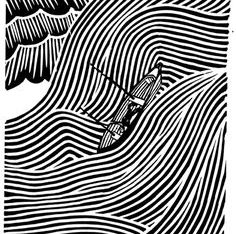 Theory of irony by Reijo Virtanen
Theory of irony by Reijo Virtanen
I have been teaching ironical writing for almost twenty years. Before that I wrote many ironical columns and sketches during my years at the university, and also made some academic research on the topic.
In this autumn, my latest class of ironical writing was one of the first classes that our college started to teach to the first-year students. For a moment, I was once again wondering, is it really a good idea to teach this extremely difficult rhetorical figure of speech to newcomers. But then I remembered some important points:
– In writers’ schools it is typical to teach Aristotelian poetics to newcomers, and what about the classical favorites, like Oedipus by Sophocles – are they not ironical?
– I also remembered my own hobby from the 1970’s. As a 12-year-old boy I used to write pastiches about Mark Twain’s ironical columns. So, the task should be very easy.
Actually, irony is not only a figure of speech. It is not only a literary technique, or method. It is basically something more. To announce it philosophically, irony means an attitude towards life. Being ironical means that you, as a writer, are prepared – anytime – to look at things dialogically, from somebody else’s point of view. Or, simultaneously from many contrary, or even contradictory points of views.
By the way, isn’t that something that every writer has to learn in order to turn professional? To enter into the minds of his / her characters and – of course the narrator, too. So, I think that training on irony is fine training for all playing with viewpoints.
After the latest course I am even more certain than before that irony must belong to the basics of creative writing, not only the basics of humor and satire.
However, in my latest workshop we were concentrating on irony as a device in humorous and satirical writing, only.
I have to thank Wayne C. Booth, Douglas C. Muecke, and Linda Hutcheon for their scholarly efforts in the field of irony. But the dearest theoretician for me above all has been Mikhail Bakhtin, the Russian heretic and anti-formalist who passed away just before the Perestroika of Mikhail Gorbatshev. Bakhtin’s theories of carnivalism and dialogism have been very important for my work as a writer of ironical sketches and columns. And also for my works as a scholar and a teacher.
Irony is one of the literary devices that have their roots in carnival festivities. For example parody, grotesque, macabre and burlesque are also carnivalistic devices. The development of literary laughter started from old fertility rites long before the classical comedy.
Carnival is a masquerade. In the beginning of festivities people put an amusing, or frightening mask on their face. They also disguise themselves in strange clothes, or forms of grotesque creatures. They start to act in an abnormal way, and speak in an inappropriate, or indecent manner. All kinds of freak shows, parodical acts and playful blasphemies are allowed and favored during carnival period. The same tendency will be found behind all the shows. All that is basically ironical!
Originally the words behind irony, eironeia and eiron mean ‘pretending’ and ‘pretender’. For example the Greek philosopher Socrates, as a famous eiron, used to pretend that he is a simpleminded person in his dialogues with other philosophers. But the people in carnival do not pretend, Bakhtin says, for they really live the carnival life. In a mysterious ritual of mental metamorphoses they have really turned to somebody else. For a short period of few days they have a glorious opportunity to live the life of people who belong to a different social class, to a different age group, to a different sex, to a different species of living creatures. A rich man may turn into a beggar. An ordinary citizen may turn into a king. A lady may turn into the Pope. A human being turn into a bush or a tree.
And that is exactly what will happen also in the literary act of irony, if you want to write a powerful and efficient text. You can write your ironic speech as the president himself, or as the Pope himself, not just pretending to be the president or the Pope. If you are a woman, you can write a vindication of machoism as a man, and vice versa.
The same process is possible in a dialogue, or a tale. In a mysterious ritual of metamorphoses the writer turns into the narrator, and then to one character after another, shifting constantly from one disguise to another. And the play of eironeia continues throughout the whole text. And in this shifting process the writer really lives the life of all his or her narrator and characters.
But then you ask, what is the purpose of that literary masquerade?
It is well-known that irony, as well as all devices of humor and satire, can be used in malicious purposes. However, in our workshops of carnivalistic irony the aims are always democratic and humane. The basic idea of carnival and carnivalism is to encourage people with the help of laughter, to give them self-confidence and cut down all fears. Everyday life of all people is full of threads or terrors. When opening the daily paper, you cannot avoid news of robberies, gunfights, wars, hurricanes, floods, the whole climate change – and new Ice Age coming soon! You also read about corrupted politicians, fraud doctors, criminal-minded policemen, mad soldiers, megalomaniac presidents, bombastic dictators, and institutions and societies of the fascist type.
The targets of carnivalistic irony are typically those people and institutions that pretend to be high above the ordinary society. Their task should be to govern and serve in a wise and benevolent way, but suddenly they start to behave against the people and their country. Why one artist in America sculptured a toilet pot which look likes the smiling face of The President of the United States, George W. Bush? Why the Nobel Prize winner Dario Fo started to write a farce where Silvio Berlusconi is haunted by a group of witches? Why the dictators in Charles Chaplin’s and Sacha Baron Cohen’s films are so …. well … childish? Why
To put it short:
The aim of irony is to distort and exaggerate in order to make the target of laughter to look extremely stupid or evil. The target, whether a person or an institution, will reveal one’s stupidity, or evilness in one’s speech, or acts. In a skillful irony the writer does not insult or criticize the target directly. By using Mikhail Bakhtin’s terminology, in irony the target alone degrades and disgraces itself.
Methods of teaching irony
In this autumn, my workshop of irony lasted for 20 hours, during four separate days and within one month. Between workshop meetings there were exercises.
You cannot start writing irony just right away. You’ll have to have some preparations. First, the writer must have an opportunity to choose a topic which is very important and emotionally moving especially to her / him. It is also important that the topic is factual, not fictional. Ironical texts speak about this mutual world of all people. If the topic were untrue, the writer would not be serious enough in his / her laughing. Ironical laughter is indeed a serious matter, or serio-comical, as Bakhtin writes.
During our classes we often go to the college library or computer class in order to find serious topics from the media. This time students went to the internet and came back with pieces of news which they considered strongly touching.
The first exercise during classes was to write 15 lines about the chosen topic for a serious column. The students were ordered to take a very sharp point of view and clear attitude towards their subject. We could call this a monological, or one-voiced point of view (again using to Bakhtin’s theory). Of course the final aim on classes of irony is to learn dialogism. But how can the writer know what is dialogical writing, if he or she has not first experienced what is monological writing?
Most of the topics, that the students chose, were really very serious. For example, one text was about some homeless students living in container boxes, another text about mental depression, one about the medicalization of society, and still another one about the increase in number of suicides. From these universal topics, it seemed to be an easy route to move on to laughter and irony.
But before any homework, the students needed a shock effect to shake them away from their ordinary humane thought towards something totally opposite. I considered the Irish-English priest Jonathan Swift would be a great poison for these purposes. When reading Swift’s Modest proposal, from the early 18th century, the readers were persuaded to identify with the sinister idea and viewpoint of Swift’s text. The narrator there is an evil gourmand who appears to belong to the English noble classes. To put it shortly, the narrating nobleman of Swift’s pamphlet gives a short cut solution to the starvation and sufferings of Irish children. The babies ought to be utilized as groceries (foodstuff) when cooking meals to the rich English gentlemen. This reader’s act is comparable with the grotesque disguise of carnival characters. It means being somebody else and thinking someone else’s thoughts. Also it means looking at the world from somebody else’s point of view.
The first homework was about verbal irony. The students were supposed to write a 1- to 2-page-long essay about the same topic they had chosen from the Internet. Now they had to take the attitude of an enemy, or of somebody else, whose ideas and viewpoints they opposed. Of course, the enemies were supposed to be also found from the news. And they were.
When writing about medicalization, could you normally identify with the viewpoint of a fascist doctor? This doctor talks deliberately about weak individuals who are not capable for living in our society? And could you make yourself to invent the best means for getting rid of the weak and crippled people? No! But in irony everything is possible. After reading Swift you are more than willing to do it. At this very moment, I have to remind you about irony: it means “saying something but implying the opposite”. So, the fascist narrator in an ironical text is only a boastful marionette in the hands of a humane and democratic writer. The doctor with his absurd logic is like the braggart soldier of an ancient Greek comedy. He is the one who finally turns out to be stupid or evil, and the target of our ironical satire.
In verbal irony we have now already moved from monologism to dialogism, or double-voiced discourse, as Bakhtin would say. There the writer’s aims are opposed to those of her or his narrator.
The next step – after verbal irony – was to learn dramatizing irony. It means that the writer has to invent more than one character to join in a dialogue (discussion or argument) and to create a plot for their acts. Dramatized irony means a structure where the expectations of the main character or the reader, or both, are frustrated. We expect something to happen, but in result, something else happens.
After my workshop I have come to a certain conclusion:
The teacher of irony ought to be very careful in choosing the exemplary text. It should be a short and a simple one, like Boccaccio’s short stories. My latest example was too long and too sarcastic – not ironical enough. It was a short story of Veikko Huovinen, a Finnish master of satirical humor – and not one of his best. But luckily, my error did not prevent the students from doing their job: they finally created ironical – and also funny – plots.
The topic for their short stories was again supposed to be the same as in the original news.
The student who had chosen suicide as her topic, drove her characters to the Moon like satirist Lucian did in the ancient Greece. There, on the surface of the Moon a young girl and her mother started to solve their family problems. The dialogue was ironical and the story terribly macabre.
The writer, who had chosen depression as her topic, wrote a science fiction parody resembling Jonathan Swift’s type, inventing absurd acts and dialogues between irrational scientists and foolish computers.
The writer, who had chosen medicalization as her topic, wrote a horror story parody about a doctor who begins to meddle with drugs himself and will be driven to deep nightmares with medical conmen (= cheating consultants) and their Kafka-type offices appearing and suddenly vanishing.
Results
Most of the students found their way from the direct speech of a monological piece of news to a dialogical expression of ironical columns and essays. On the next stage the same students found their way to the dialogical expression of dramatized irony. Some missed the point and continued writing one-voiced discourse foregrounding their straightforward opinions and attitudes.
During a workshop of irony we have to change a writer, who is a virtuoso of styles, into a carnivalistic person. In a carnivalistic act of creating a column, or a story, the writer is not just handling with words or phrases, but he or she must learn to live the life of others. The writer must assimilate with the characters and adopt their attitudes, and posit them into a dialogue, both in the level of speech and the level of plot.
At the first steps of one’s workshop, the description of the main ideas of carnival is very important but perhaps even more important it is to find appropriate examples of ironical writing. You just have to find texts which contain a vast variety of dialogue of attitudes. As Bakhtin insists, Dostoyevsky and other writers of irony have absorbed their carnivalism by reading texts of their skillful predecessors like Rabelais, Cervantes, Shakespeare, Voltaire, Swift, and many others.
Conclusion
Irony is not just a technique but a philosophy. It means an attitude towards life.
Reijo Virtanen
Theories of laughter and irony:
Bakhtin, Mikhail: Problems of Dostoyevsky’s Poetics
Bakhtin, Mikhail: Rabelais and His World
Booth, Wayne C.: A Rhetoric of Irony
Hutcheon, Linda: Irony’s Edge. The Theory and Politics of Irony
Muecke, Douglas C.: The Compass of Irony




